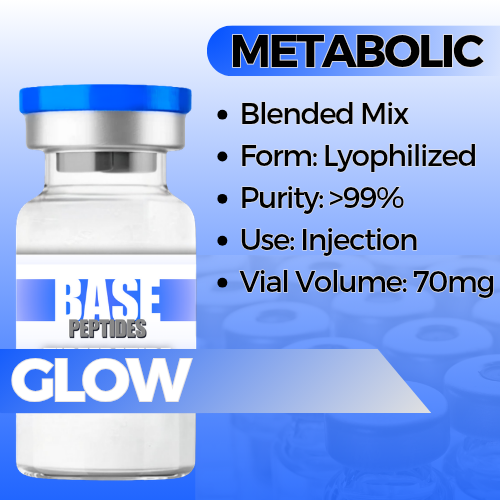GLOW
GLOW
Base Peptides are intended for licensed medical professionals and experienced researchers. Reconstitution required. Dosing and use instructions are not provided.
Couldn't load pickup availability
GLOW — GHK-Cu + BPC-157 + TB-500 Research Blend
GLOW combines three complementary research peptides—50mg of GHK-Cu (copper-binding tripeptide), 10mg of BPC-157 (gastric “Body Protection Compound” fragment), and 10mg of TB-500 (Thymosin-β4 research fragment). The blend is designed for laboratories exploring ECM/tissue remodeling, barrier integrity, cell migration, and angiogenic signaling in skin, tendon/ligament, and endothelial models.
- Core motif: Gly-His-Lys·Cu(II) (tripeptide–copper complex)
- Focus: ECM gene programs (collagens, integrins), antioxidant/metal-binding context, fibroblast & keratinocyte endpoints.
- Notes: Copper coordination is central—document buffer and pH in your methods.
- Sequence (15 aa): GEPPPGKPADDAGLV
- Focus: Epithelial/endothelial barrier metrics, cytokine balance, migration and tubulogenesis assays.
- Notes: Often examined in TEER, tight-junction, and wound-closure models.
- Parent protein: Thymosin-β4 (43 aa)
- Focus: Actin binding & cytoskeletal dynamics, cell motility, angiogenic sprouting.
- Notes: Useful for dissecting migration speed, focal-adhesion turnover, and sprout length.
Why This Blend
Complementary Mechanisms
- 50mg GHK-Cu → ECM & trophic gene expression; matrix organization.
- 10mg BPC-157 → Barrier support & angiogenic cues.
- 10mg TB-500 → Motility and actin-cytoskeleton remodeling.
Design Advantages
- Run a single protocol to capture matrix + barrier + migration endpoints.
- Adjust ratios to emphasize ECM (GHK-Cu), barrier (BPC-157), or motility (TB-500).
- Add single-agent control arms to quantify additivity vs synergy.
Potential Research Applications
Dermal/ECM Panels
- Collagen I/III, elastin, laminin; MMP/TIMP balance
- Fibroblast proliferation & morphology
Barrier & Endothelium
- TEER (tight-junction integrity), permeability assays
- VE-cadherin, ZO-1, occludin readouts
Migration & Angiogenesis
- Scratch/wound-closure, live-cell motility tracking
- Tubulogenesis & 3D sprouting assays
Design Notes
- State salt/form for each component (e.g., GHK-Cu complex, BPC-157 acetate, TB-500 acetate).
- Document vehicle, pH, ionic strength, and serum lot—endpoints are condition-sensitive.
- Include single-agent and vehicle controls for mechanism clarity.
Key Study Themes (Educational Summary)
GHK-Cu — matrix & trophic signaling
- Frequently associated with up-regulating ECM and repair genes in skin/dermal models.
- Consider copper-free controls to isolate metal-coordination effects.
BPC-157 — barrier biology & angiogenic cues
- Reported effects on tight junction proteins and endothelial tubulogenesis.
- Use TEER/permeability plus cytokine panels for a complete picture.
TB-500 — cytoskeleton & motility
- Examined for effects on actin binding, migration speed, and sprouting length.
- Pair imaging (phalloidin, vinculin) with functional migration endpoints.
Synergistic Peptides (for Study Design)
LL-37
- Why pair: Epithelial defense & wound context to complement barrier/ECM work.
- Angle: Co-culture wound models with cytokine readouts.
Tα1 (Thymosin-α1)
- Why pair: Immune-modulation alongside repair endpoints.
- Angle: Th1/Th2 panels + barrier metrics under challenge.
SS-31 (Elamipretide)
- Why pair: Mitochondrial membrane support during repair stress.
- Angle: Δψm/ATP metrics + migration/ECM assays.
Controls
- Run GHK-Cu-only, BPC-only, TB-only arms to map contribution of each component.
- Include copper chelator or metal-free conditions where relevant.
Known Concerns (Context)
- Co-formulation: Verify compatibility (pH, buffer salts, chelators) so GHK can bind copper as intended and other peptides remain stable.
- Stability: Prepare fresh aliquots; minimize freeze–thaw; protect from light/moisture.
- Model variability: Outcomes can vary with substrate coatings, serum lots, and cell passage—document conditions tightly.
- General: For laboratory research use only; not for human consumption or therapeutic use.
Specifications & Handling
- Form: Lyophilized powders premixed (lot-coded); label indicates blend ratio
- Purity (each): ≥ 99% (HPLC/MS verified)
- Storage: ≤ −20 °C; dry, low-light conditions
- In solution: Use sterile diluent; record pH/vehicle and time-to-use; aliquot immediately
- Packaging: Tamper-evident; research-only labeling.
Regulatory & Use Notice
Sold for laboratory research use only. Not for human consumption, medical, or veterinary use. No human-use instructions are provided. Buyer is responsible for safe handling and regulatory compliance.
GLOW Research Blend | GHK-Cu + BPC-157 + TB-500 | ECM Remodeling, Barrier Integrity, Migration & Angiogenesis


